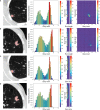Comparison of Radiomic Models Based on Low-Dose and Standard-Dose CT for Prediction of Adenocarcinomas and Benign Lesions in Solid Pulmonary Nodules
- PMID: 33604303
- PMCID: PMC7884759
- DOI: 10.3389/fonc.2020.634298
Comparison of Radiomic Models Based on Low-Dose and Standard-Dose CT for Prediction of Adenocarcinomas and Benign Lesions in Solid Pulmonary Nodules
Abstract
Objectives: This study aimed to develop radiomic models based on low-dose CT (LDCT) and standard-dose CT to distinguish adenocarcinomas from benign lesions in patients with solid solitary pulmonary nodules and compare the performance among these radiomic models and Lung CT Screening Reporting and Data System (Lung-RADS). The reproducibility of radiomic features between LDCT and standard-dose CT were also evaluated.
Methods: A total of 141 consecutive pathologically confirmed solid solitary pulmonary nodules were enrolled including 50 adenocarcinomas and 48 benign nodules in primary cohort and 22 adenocarcinomas and 21 benign nodules in validation cohort. LDCT and standard-dose CT scans were conducted using same acquisition parameters and reconstruction method except for radiation dose. All nodules were automatically segmented and 104 original radiomic features were extracted. The concordance correlation coefficient was used to quantify reproducibility of radiomic features between LDCT and standard-dose CT. Radiomic features were selected to build radiomic signature, and clinical characteristics and radiomic signature were combined to develop radiomic nomogram for LDCT and standard-dose CT, respectively. The performance of radiomic models and Lung-RADS was assessed by area under curve (AUC) of receiver operating characteristic curve, sensitivity, and specificity.
Results: Shape and first order features, and neighboring gray tone difference matrix features were highly reproducible between LDCT and standard-dose CT. No significant differences of AUCs were found among radiomic signature and nomogram of LDCT and standard-dose CT in both primary and validation cohort (0.915 vs. 0.919 vs. 0.898 vs. 0.909 and 0.976 vs. 0.976 vs. 0.985 vs. 0.987, respectively). These radiomic models had higher specificity than Lung-RADS (all correct P < 0.05), while there were no significant differences of sensitivity between Lung-RADS and radiomic models.
Conclusions: The diagnostic performance of LDCT-based radiomic models to differentiate adenocarcinomas from benign lesions in solid pulmonary nodules were equivalent to that of standard-dose CT. The LDCT-based radiomic model with higher specificity and lower false-positive rate than Lung-RADS might help reduce overdiagnosis and overtreatment of solid pulmonary nodules in lung cancer screening.
Keywords: benign lesion; low-dose computed tomography; lung adenocarcinoma; lung cancer screening; radiomics; solid pulmonary nodule.
Copyright © 2021 Liu, Xu, Qing, Li, Yang, He, Ren and Zhou.
Conflict of interest statement
The authors declare that the research was conducted in the absence of any commercial or financial relationships that could be construed as a potential conflict of interest.
Figures




Similar articles
-
Prediction of invasive adenocarcinomas manifesting as pure ground-glass nodules based on radiomic signature of low-dose CT in lung cancer screening.Br J Radiol. 2022 May 1;95(1133):20211048. doi: 10.1259/bjr.20211048. Epub 2022 Jan 20. Br J Radiol. 2022. PMID: 34995082 Free PMC article.
-
Reproducibility of radiomic features of pulmonary nodules between low-dose CT and conventional-dose CT.Quant Imaging Med Surg. 2022 Apr;12(4):2368-2377. doi: 10.21037/qims-21-609. Quant Imaging Med Surg. 2022. PMID: 35371962 Free PMC article.
-
Quantitative radiomic model for predicting malignancy of small solid pulmonary nodules detected by low-dose CT screening.Quant Imaging Med Surg. 2019 Feb;9(2):263-272. doi: 10.21037/qims.2019.02.02. Quant Imaging Med Surg. 2019. PMID: 30976550 Free PMC article.
-
The Pivotal Role of Baseline LDCT for Lung Cancer Screening in the Era of Artificial Intelligence.Arch Bronconeumol. 2025 Jun;61(6):359-367. doi: 10.1016/j.arbres.2024.11.001. Epub 2024 Nov 22. Arch Bronconeumol. 2025. PMID: 39643515 Review. English, Spanish.
-
Risk assessment in relation to the detection of small pulmonary nodules.Transl Lung Cancer Res. 2017 Feb;6(1):35-41. doi: 10.21037/tlcr.2017.02.05. Transl Lung Cancer Res. 2017. PMID: 28331822 Free PMC article. Review.
Cited by
-
Prediction of invasive adenocarcinomas manifesting as pure ground-glass nodules based on radiomic signature of low-dose CT in lung cancer screening.Br J Radiol. 2022 May 1;95(1133):20211048. doi: 10.1259/bjr.20211048. Epub 2022 Jan 20. Br J Radiol. 2022. PMID: 34995082 Free PMC article.
-
Identification of pulmonary adenocarcinoma and benign lesions in isolated solid lung nodules based on a nomogram of intranodal and perinodal CT radiomic features.Front Oncol. 2022 Sep 6;12:924055. doi: 10.3389/fonc.2022.924055. eCollection 2022. Front Oncol. 2022. PMID: 36147924 Free PMC article.
-
An ordinal radiomic model to predict the differentiation grade of invasive non-mucinous pulmonary adenocarcinoma based on low-dose computed tomography in lung cancer screening.Eur Radiol. 2023 May;33(5):3072-3082. doi: 10.1007/s00330-023-09453-y. Epub 2023 Feb 15. Eur Radiol. 2023. PMID: 36790469
-
Impact of slice thickness on reproducibility of CT radiomic features of lung tumors.F1000Res. 2023 Dec 1;12:1319. doi: 10.12688/f1000research.141148.2. eCollection 2023. F1000Res. 2023. PMID: 38454921 Free PMC article.
-
Deep learning predicts malignancy and metastasis of solid pulmonary nodules from CT scans.Front Med (Lausanne). 2023 May 19;10:1145846. doi: 10.3389/fmed.2023.1145846. eCollection 2023. Front Med (Lausanne). 2023. PMID: 37275359 Free PMC article.
References
-
- GBD Causes of Death Collaborators Global, regional, and national age-sex-specific mortality for 282 causes of death in 195 countries and territories, 1980-2017: a systematic analysis for the Global Burden of Disease Study 2017. Lancet (2018) 392(10159):1736–88. 10.1016/S0140-6736(18)32203-7 - DOI - PMC - PubMed
LinkOut - more resources
Full Text Sources
Other Literature Sources

